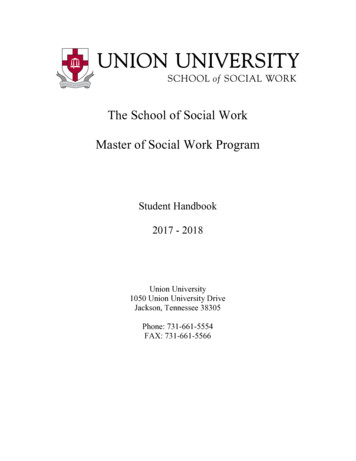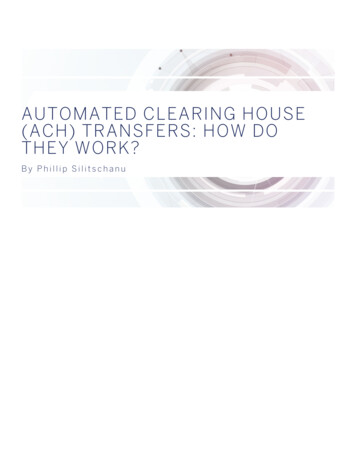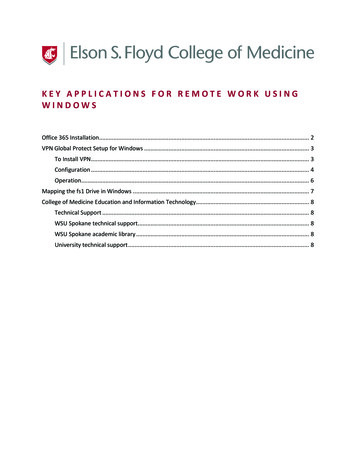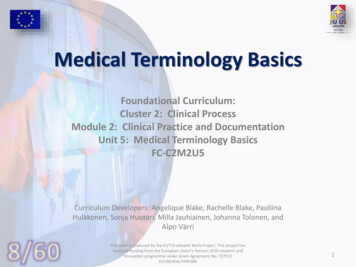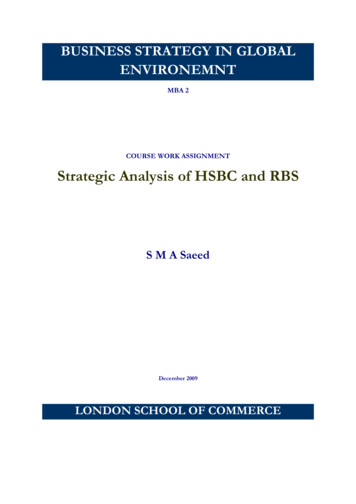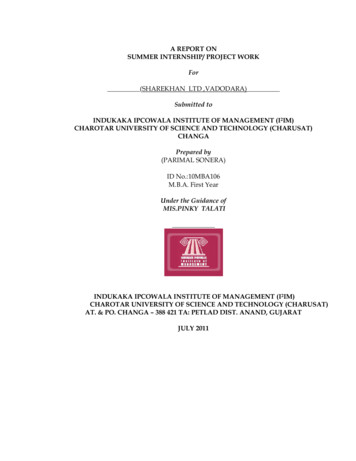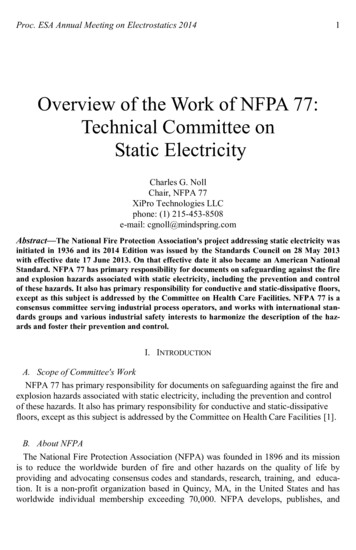
Transcription
Proc. ESA Annual Meeting on Electrostatics 20141Overview of the Work of NFPA 77:Technical Committee onStatic ElectricityCharles G. NollChair, NFPA 77XiPro Technologies LLCphone: (1) 215-453-8508e-mail: cgnoll@mindspring.comAbstract—The National Fire Protection Association's project addressing static electricity wasinitiated in 1936 and its 2014 Edition was issued by the Standards Council on 28 May 2013with effective date 17 June 2013. On that effective date it also became an American NationalStandard. NFPA 77 has primary responsibility for documents on safeguarding against the fireand explosion hazards associated with static electricity, including the prevention and controlof these hazards. It also has primary responsibility for conductive and static-dissipative floors,except as this subject is addressed by the Committee on Health Care Facilities. NFPA 77 is aconsensus committee serving industrial process operators, and works with international standards groups and various industrial safety interests to harmonize the description of the hazards and foster their prevention and control.I. INTRODUCTIONA. Scope of Committee's WorkNFPA 77 has primary responsibility for documents on safeguarding against the fire andexplosion hazards associated with static electricity, including the prevention and controlof these hazards. It also has primary responsibility for conductive and static-dissipativefloors, except as this subject is addressed by the Committee on Health Care Facilities [1].B. About NFPAThe National Fire Protection Association (NFPA) was founded in 1896 and its missionis to reduce the worldwide burden of fire and other hazards on the quality of life byproviding and advocating consensus codes and standards, research, training, and education. It is a non-profit organization based in Quincy, MA, in the United States and hasworldwide individual membership exceeding 70,000. NFPA develops, publishes, and
Proc. ESA Annual Meeting on Electrostatics 20142disseminates more than 300 consensus codes and standards intended to minimize the possibility and effects of fire and other risks [2].NFPA staff in the United States and abroad develops collaborative relationships withgovernment, fire and life safety officials, and professional, industrial and technical organizations across the globe to promote the use and adoption of its codes and standards. Partnering with the fire service, code development and enforcement authorities, anddesign professionals such as architects and engineers, NFPA makes its technical information available to support countries and regions in developing or enhancing their codes,standards, and safety practices.As part of its commitment to enhancing public safety, NFPA makes its codes and standards available online to the public for free at formation-pages. You may recognize the National Fire ProtectionAssociation by its logos - Fig. 1.Fig. 1. Logos of the National Fire Protection AssociationC. Official Statement of Scope for the Document NFPA 77: Static Electricity1.1 Scope.1.1.1 This recommended practice applies to the identification, assessment, andcontrol of static electricity for purposes of preventing fires and explosions.1.1.2* This recommended practice does not apply directly to shock hazards fromstatic electricity. However, application of the principles set forth in this recommended practice can reduce such shock hazards to personnel.1.1.3* This recommended practice does not apply to the prevention and controlof static electricity in hospital operating rooms or in areas where flammable anesthetics are administered or handled.1.1.4* This recommended practice does not apply to lightning.1.1.5* This recommended practice does not apply to stray electrical currents orto induced currents from radio frequency (RF) energy.1.1.6* This recommended practice does not apply to fueling of motor vehicles,marine craft, or aircraft.1.1.7* This recommended practice does not apply to clean rooms.1.1.8 This recommended practice does not apply to control of static electricityand static electricity hazards involved with electronic components, which havetheir own requirements.
Proc. ESA Annual Meeting on Electrostatics 20143Any item with an asterisk (*) beside its paragraph number has appendix material inNFPA 77: Static Electricity that generally refers readers to documents that are applicable.I bring this to your attention, because it is important for you to know where our interestlies and what other areas of electrostatics are of concern to NFPA. Our primary focus ison industrial electrostatic processes.The committee operates under NFPA administration and support, and our liaison withNFPA is Mr. Robert Benedetti.II. RESPONSIBILITIES OF CHAIR AND TECHNICAL COMMITTEE MEMBERSMembers and the Chair of NFPA technical committees are mindful that their guidancedocument and recommendations are used at the plant level by individuals working withthe development and operation of manufacturing processes. The users are generally notexperts in the research areas of electrostatic processes. The primary concern of everyoneinvolved is safety. NFPA 77: Static Electricity is a source for plant-safety protocols, decisions on insurability, and discovery where there might be injury or death from a fire orexplosion.In any user situation, the Authority Having Jurisdiction must make decisions based onexperience and knowledge gained from documents and consults as needed. Commercialprocesses are typically proprietary and only the owners of those processes know what isunique to them in such ways that an Authority Having Jurisdiction can function appropriately. The work of this committee serves the expressed needs of industrial applicationswhere electrostatic processes are active.NFPA 77: Static Electricity is one recognized source of industry experience. It is a recommended and not required practice for operations involving static electricity. NFPA,NFPA Technical Committee 77, and its members do not guarantee safety in any application. There are disclaimers and such in all NFPA documents and no comment made hereextends or validates meaning of the guidance.NFPA 77: Static Electricity is a consensus document. It is not a research document.NFPA requires the committee to be composed of a diverse membership, including balanced representation from manufacturers, users, insurers, special experts, researchers, etc.Before an applicant can be appointed to the committee, a formula is applied to assure thebalance is maintained through the appointment. Most committee members have more than20 years experience in electrostatic safety. Special experts are typically consultants orretirees, and often must be placed on a waiting list until other representations can be increased or a special expert leaves the committee.I joined NFPA 77 in 1996 and became Chair in 2006. When you become Chair youcommit to be in that position for ten years. I am charged to facilitate discussion yet notdetermine what is acceptable content of our document. In a meeting the existing and proposed changes are discussed by those in attendance - all revision is in projection at livemeetings or on computer screen by electronic conference. After discussion at a meeting,recommended changes are sent out for consideration by the entire committee and there isa committee vote. In time and after possible additional discussion and revision, the pro-
Proc. ESA Annual Meeting on Electrostatics 20144posed changes and reasons for those proposed changes are sent out for public comment.We then meet again to answer concerns. There is a well-planned schedule for comment,review, voting, etc., that ultimately leads to a revised document.There is a process for changes to NFPA 77: Static Electricity, and peer review is anopen process of public comment. Much of the work of the committee addresses concernsraised by the public and changes are considered made by consensus of the committee. Thechange process is automated and tracked through online services. Approved changes areidentified in each revision of the document. There is typically a three-to-five year revisioncycle.Work continues between revision cycles and NFPA Documents may be amended by theissuance of Tentative Interim Amendments or corrected by Errata. An official NFPADocument at any point in time consists of the current edition of the document togetherwith any Tentative Interim Amendment and any Errata then in effect.There is much more to be said about the operation of a consensus committee, and I willprovide some of that at the meeting of the IEEE-IAS Electrostatic Processes Committeein October 2014.III. STATUS OF WORK AND REVISIONSThe 2014 Edition of NFPA 77: Static Electricity was issued by the Standards Council ofNFPA on 28 May 2013 with effective date 17 June 2013. On that effective date it alsobecame an American National Standard.The document contains new material and numerous revisions. I will not list them here;you can find them highlighted in the document in subject areas that interest you.The major change occurs in the outline of the document, and this reflects the intent toexpand some sections in future editions. We are following developments in Europe andseeking to establish some guidance and conformity in areas such as filling of vessels, hoses/fittings, powder/bulk solids handling, etc. In areas of fundamentals, there is an ongoingstruggle over the use of intensive/extensive quantities to describe hazard conditions. Whatseems somewhat obvious to researchers is very complex in applications that are multidisciplinary and spanning many industries.NFPA 77: Static Electricity now contains eighteen chapters. I'll attempt to group themso that you can see what the document is all about: Chapters 1-4 Set the stage - administration; referenced publications; definitions;units and symbols of measure. Chapters 5-8 Gives general direction - fundamentals of static electricity; evaluating static electricity hazards; control of static electricity and its hazards by process modification, static eliminators, and personnel factors. Chapters 9-12 Liquids - flammable and combustible liquids and their vapors;fluid flows in piping, hose, tubing, and filters; containers and intermediate bulkcontainers; and bulk storage tanks and tank vehicles. Chapters 13-14 Process vessels and operations in process vessels. Chapters 15-16 Powders and dusts and intermediate bulk containers for powders.
Proc. ESA Annual Meeting on Electrostatics 2014 5Chapter 17 Web and sheet processes.Chapter 18 Miscellaneous applications - spray applications and coating, beltsand conveyors, explosives, cathode ray tube video display terminals (X), plasticsheets and wraps.There are ten appendices including glossary, bibliography, and other informational references. These appendices help form the context of recommended practice, but are notpart of the recommendations of the document.IV. CONCLUSIONSince 1936 the National Fire Protection Association has been supporting industry withguidance to help safeguard industrial process operators from the hazards of static electricity. NFPA 77: Static Electricity consists of nineteen members, three alternates, and a nonvoting Emeritus Member.The current issue of our guidance document issued in May 2013, and we are welcomingnew materials for the next edition through our web-based revision processing system. Wealso seek additional membership from the research community, safety-related associations, manufacturers, and users of electrostatic processes.REFERENCES[1][2]NFPA 77 Recommended Practice on Static Electricity (2014 Edition). Available from NFPA, 1Batterymarch Park, P.O. Box 9101, Quincy, MA 02269-9101, USA.NFPA Website: http://www.nfpa.org/about-nfpa.
The 2014 Edition of NFPA 77: Static Electricity was issued by the Standards Council of NFPA on 28 May 2013 with effective date 17 June 2013. On that effective date it also became an American National Standard. The document contains new material and numerous revisions. I will not list them here; you can find them highlighted in the document in subject areas that interest you. The major change .

